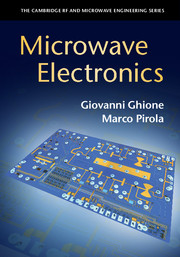Book contents
- Frontmatter
- Dedication
- Contents
- Preface
- Notation and Symbols
- 1 A System Introduction to Microwave Electronics
- 2 Passive Elements and Circuit Layout
- 3 CAD Techniques
- 4 Directional Couplers and Power Dividers
- 5 Active RF and Microwave Semiconductor Devices
- 6 Microwave Linear Amplifiers
- 7 Low-Noise Amplifier Design
- 8 Power Amplifiers
- 9 Microwave Measurements
- 10 CAD Projects
- Index
- References
9 - Microwave Measurements
Published online by Cambridge University Press: 10 November 2017
- Frontmatter
- Dedication
- Contents
- Preface
- Notation and Symbols
- 1 A System Introduction to Microwave Electronics
- 2 Passive Elements and Circuit Layout
- 3 CAD Techniques
- 4 Directional Couplers and Power Dividers
- 5 Active RF and Microwave Semiconductor Devices
- 6 Microwave Linear Amplifiers
- 7 Low-Noise Amplifier Design
- 8 Power Amplifiers
- 9 Microwave Measurements
- 10 CAD Projects
- Index
- References
Summary
Introduction
This chapter aims at providing an overview of the experimental characterization techniques of linear and nonlinear one- and two-ports. After a short review of some basic instrumentation tools (the power meter, the vectorial voltmeter, the spectrum analyzer) in Sec. 9.2, the characterization of linear one- and two-ports, such as passive circuits and linear amplifiers, based on the measurement of power waves (see Sec. 3.2.2) and the related circuit-oriented parameters are discussed. As a first example, one-port measurements are introduced, whose fundamental tool is the so-called reflectometer (Sec. 9.3). The analysis of the reflectometer already allows the main issues involved in microwave measurement set-ups to be discussed, such as: the use of directional couplers to separate incident and reflected waves at the port where the Device Under Test (DUT) is connected; the need to perform measurements at a suitably low Intermediate Frequency (IF) rather than at RF to improve accuracy; the need to calibrate the measurement system to correct for systematic errors in the instrumentation.
In Sec. 9.4 the discussion is extended to the characterization of two-port linear devices adopting the two-port Vector Network Analyzer (VNA), the key instrument for high-frequency characterization first introduced by Hewlett Packard, around 1970 [2, 3]. Downconversion approaches are discussed in Sec. 9.4.1, while a number of calibration strategies are reported in Sec. 9.4.2.
Large-signal rather than linear-only characterizations are fundamental in the experimental assessment of power amplifiers. In Sec. 9.5 the most important aspects related to load-pull measurements are discussed. Sec. 9.6 is devoted to system-level characterization of RF components under modulated signal excitation, with particular attention to power amplifiers. Finally, Sec. 9.7 presents an overview of noise measurement techniques.
Basic Microwave Instrumentation Tools
Microwave measurements exploit a number of tools that are also commonly found in low-frequency electronic or electrical characterizations. Their function and principle of operation will be briefly recalled here.
Power meters are instruments able to measure the power dissipated by a resistive load being part of the meter.
- Type
- Chapter
- Information
- Microwave Electronics , pp. 489 - 521Publisher: Cambridge University PressPrint publication year: 2017



